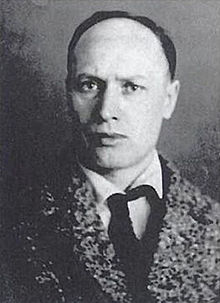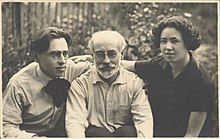Platformism
| Part of a series on |
| Platformism |
|---|
 |
Platformism is an anarchist organizational theory that aims to create a tightly-coordinated anarchist federation. Its main features include a common tactical line, a unified political policy and a commitment to collective responsibility.
First developed by
History
Precursors
The roots of platformism go back as far as the organizational principles of Mikhail Bakunin,[1] particularly in his theory of "organisational dualism". Bakunin proposed that anarchists form their own revolutionary organisations that would encourage workers to rebel against the state and capitalism, and once a social revolution had replaced the state with a federation of voluntary associations, it would then agitate against any attempted reconstitution of the state by political parties.[2]
The Platform's most direct predecessor was the
Meanwhile, the Nabat Confederation of Anarchist Organizations, which had originally been established as a loose-knit organization, developed into a tightly-organized structure with a unified policy and an executive committee, in what a member would later describe as a precursor to platformism.[6]
Formulation

After their flight into exile, Russian and Ukrainian anarchists began to call for the reorganization of the anarchist movement, considering that chronic disorganization had led to their defeat during the Revolution.[7] Among the anarcho-communists, Peter Arshinov was the most vocal advocate of reorganization.[8]
On 20 June 1926, the Organizational Platform of the General Union of Anarchists (Draft) was published in Delo Truda, with an introduction penned by Arshinov.[9] Considering the goal of anarchism to be a social revolution that would create a stateless and classless society, the Platform proposed the establishment of a General Union of Anarchists to educate the working class and raise class consciousness.[10] This General Union was to be organised according to the principles of theoretical unity, tactical unity and collective responsibility,[11] and would be governed by an executive committee that coordinated collective action and political policy.[12]
Debate
The Platform was first presented at a meeting of the Delo Truda group, with attendees also including

The Platform's harshest critics included Volin, Senya Fleshin and Mollie Steimer,[17] who denounced the Platform as an attempt to create an anarchist political party,[18] which they feared would inevitably result in the formation of a police state.[17] Arshinov responded by claiming his Platform actually abided by anarchist principles, as it consciously avoided coercion and preserved decentralization.[19] The debate also took a more personal turn as Makhno and Arshinov attacked Volin, which attracted denunciations from other critics of the Platform,[20] including Alexander Berkman, who denounced Makhno as a militarist and Arshinov as a Bolshevik.[19]
After years of defending the ideas of Platformism, in the early 1930s, Arshinov joined the Communist Party and defected to the Soviet Union,[21] where he would disappear during the Great Purge.[22] Nestor Makhno himself died in 1934, leaving the Platform without any prominent defenders.[23] Nevertheless, both the opponents and remaining supporters of the Platform managed to reconcile at Makhno's funeral.[24] Volin himself took up the publication of Makhno's memoirs, which were published in the years after his death.[25]
Organizational developments
During the
In 1953, the French anarchist
Especifismo (English: Specifism) was first developed in 1972 by the Uruguayan Anarchist Federation (FAU), with the publication of its text Huerta Grande, which proposed the creation of a unified political policy directly applicable to the material conditions in Uruguay.[34] The collapse of the ruling right-wing dictatorships towards the end of the Cold War resulted in the emergence of many other especifista groups throughout Latin America, in a process spearheaded by the FAU.[35] In 2003, the Anarkismo.net website was established by an international network of anarcho-communist organizations, including both Latin American especifistas and European platformists, which publishes news and analysis in a variety of different languages.[36]
References
- ^ Darch 2020, p. 143; Graham 2018, p. 330.
- ^ Graham 2018, pp. 330–331.
- ^ Schmidt 2013, pp. 61–62.
- ^ Schmidt 2013, pp. 62–63.
- ^ Darch 2020, p. 75.
- ^ Schmidt 2013, p. 66.
- ^ Avrich 1971, pp. 238–239; Darch 2020, p. 140; Malet 1982, pp. 163–164, 190; Schmidt 2013, p. 60; Skirda 2002, p. 120.
- ^ Avrich 1971, p. 241; Skirda 2002, pp. 122–123.
- ^ Darch 2020, p. 143; Skirda 2002, p. 122, 124.
- ^ Darch 2020, pp. 143–144.
- ^ Darch 2020, p. 143; Schmidt 2013, p. 61; Skirda 2002, pp. 124–125.
- ^ Avrich 1971, p. 241; Malet 1982, p. 190; Schmidt 2013, p. 61.
- ^ Skirda 2002, p. 124.
- ^ Avrich 1971, pp. 241–242; Darch 2020, p. 144; Malet 1982, pp. 163–164, 190–191.
- ^ Darch 2020, p. 144; Skirda 2002, p. 124.
- ^ Schmidt 2013, p. 63.
- ^ a b Avrich 1971, pp. 241–242.
- ^ Avrich 1971, pp. 241–242; Darch 2020, p. 144; Malet 1982, pp. 190–191; Skirda 2002, pp. 125–126.
- ^ a b Avrich 1971, pp. 242–243.
- ^ Avrich 1971, pp. 242–243; Malet 1982, pp. 190–191.
- ^ Avrich 1971, pp. 243; Darch 2020, p. 145; Malet 1982, pp. 163–164, 191.
- ^ Avrich 1971, pp. 245–246; Darch 2020, p. 145; Malet 1982, pp. 163–164.
- ^ Darch 2020, p. 145; Malet 1982, pp. 164, 191–192.
- ^ Malet 1982, p. 164.
- ^ Malet 1982, p. 190.
- ^ Schmidt 2013, pp. 80–81.
- ^ Schmidt 2013, p. 81.
- ^ Schmidt 2013, pp. 82–84.
- ^ Schmidt 2013, pp. 94–95.
- ^ Schmidt 2013, pp. 95–96; Skirda 2002, pp. 171–172.
- ^ Schmidt 2013, p. 96.
- ^ Schmidt 2013, pp. 96–97.
- ^ Schmidt 2013, pp. 97–98.
- ^ Schmidt 2013, p. 98.
- ^ Schmidt 2013, p. 102.
- ^ Schmidt 2013, p. 105.
Bibliography
- OCLC 1154930946.
- Baker, Zoe (2023). "Organizational Dualism: From Bakunin to the Platform". Means and Ends: The Revolutionary Practice of Anarchism in Europe and the United States. OCLC 1345217229.
- Berry, David (2002). A History of the French Anarchist Movement: 1917 to 1945. LCCN 2001054702.
- Darch, Colin (2020). Nestor Makhno and Rural Anarchism in Ukraine, 1917-1921. OCLC 1225942343.
- Graham, Robert (2018). "Anarchism and the First International". In Adams, Matthew S.; Levy, Carl (eds.). The Palgrave Handbook of Anarchism. London: Palgrave Macmillan. pp. 325–342. S2CID 158605651.
- Malet, Michael (1982). Nestor Makhno in the Russian Civil War. OCLC 8514426.
- Schmidt, Michael (2013) [2012]. Cartography of Revolutionary Anarchism. OCLC 881111188.
- OCLC 490977034.
- OCLC 60602979.
- OCLC 1100238201.
Further reading
- Arshinov, Peter; Makhno, Nestor; Mett, Ida; et al. (2006) [1926]. The Organizational Platform of the General Union of Anarchists. Translated by McNab, Nestor. Delo Truda – via The Nestor Makhno Archive.
- Balius, Jaime (1978) [1938]. Towards a Fresh Revolution. Friends of Durruti Group – via The Anarchist Library.
- Fontenis, Georges (1953). Manifesto of Libertarian Communism. Libertarian Communist Federation – via The Anarchist Library.
- Makhno, Nestor; Malatesta, Errico (1927–1930). About the Platform. Translated by McNab, Nestor – via The Anarchist Library.
External links
- Anarkismo.net - Multilingual anarchist news site run by over 30 platformist and especifist organisations on five continents
